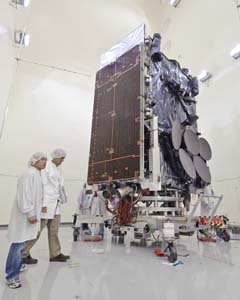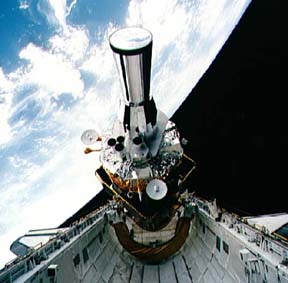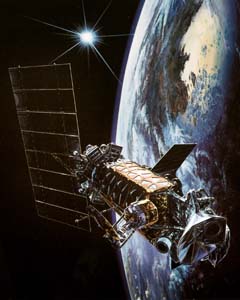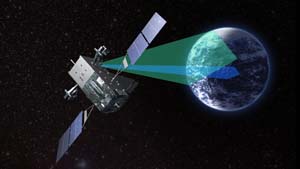The Air Force’s satellite enterprise—for many decades the developer and operator of the world’s most advanced military spacecraft—is under pressure to downshift.
Even staunch advocates of today’s sophisticated orbital systems are questioning the practice of building a few large, exquisite, government-owned spacecraft that cost billions of dollars apiece and take many years to get into service.
They say problems now confronting the US military space system require the Air Force and its industrial partners to find cheaper and faster ways to get payloads on orbit.

| ||
|
(Staff Illustration by Zaur Eylanbekov) |
Gen. William L. Shelton, head of Air Force Space Command, told the National Space Symposium in Colorado Springs, Colo., that some next generation military constellations could well feature small and relatively simple satellites. He said some defense payloads could be sent aloft on commercial spacecraft.
This recalibration, if it continues, could prove to be one of the biggest changes for USAF since it got into satellite work in the 1950s.
The movement reflects two realities. The first is the certainty of a shrinking budget. Experts say the Air Force can no longer afford sufficient numbers of the highly advanced systems and must find alternatives. The second is the undeniable and growing physical threat posed to US orbital vehicles, which are valuable, undefended—and few. Lower-cost systems could provide safety in numbers.
No one expects USAF to sharply turn away from its giant technological marvels in space. It is executing a change out of constellations that—for a while, anyway—will bring on board even more of these highly advanced, multimission spacecraft.
Shelton reported not long ago that, in his view, “the die is cast” on military constellations for the next 10 or 15 years.
Still, satellite developers have moved into “study mode,” Shelton said, trying “to determine the validity of certain ideas [that could become] game changers from a cost and security standpoint.” The awesome strengths and notable weaknesses of traditional satellite-making are seen in the constellations now in place.
Missile Warning
The legacy Defense Support Program satellite, built to detect heat from missile launches and nuclear blasts and pass the data to US users, has been a stalwart and will soldier on for a while longer. It will have to.
DSP has been around since 1970 though the youngest bird thought still to be in service was launched in 2007. The exact composition of the fleet in geosynchronous orbit is classified.

| ||
| Technicians surround a Wideband Global SATCOM in the acoustic chamber at the Boeing satellite manufacturing facility in El Segundo, Calif. WGS satellites will serve as USAF’s communications workhorses for some time forward. (Boeing photo) |
Its designated successor, the Space Based Infrared System, has had serious problems. SBIRS consists of two elements: large, dedicated satellites in geosynchronous orbit and other payloads on host satellites in highly elliptical orbits.
The first dedicated 5,600-pound SBIRS ball was launched in mid-2011, nine years behind schedule.
The program has been beset by large cost increases, too. A recent Government Accountability Office report put the tab for each satellite at $3 billion, though that number is certain to decline as more are built.
Experts chalk up much of the problem to excessive requirements, immature technologies, and complex software. Up-and-down funding added to the woes.
Shelton said the first SBIRS GEO satellite can detect dimmer and shorter-duration heat events than is possible with DSP. The new satellite also can provide more accurate missile launch and impact point predictions, compared to DSP.
“We collectively made this program very hard,” Shelton observed, “but we are seeing great data from the sensors on the spacecraft.”
Position-Navigation-Timing
The GPS constellation, comprising 31 orbiting satellites, provides time, location, and velocity data. GPS signals are used by all services as well as civilians, but are especially critical to the guidance of precision air weapons.
Replenishment of the constellation is an urgent need. As of June, two Block IIA satellites had been operating for more than 20 years. The 4,000-pound craft is expensive, so the Air Force doesn’t buy spares.
The first ball of the GPS IIF replacement generation went aloft in May 2010; it was four years behind schedule, said GAO. A second was launched in July 2011. A third is being prepared for launch this fall, and a fourth for 2013.
The first GPS IIF encountered interference as a result of its transmitter construction and antenna patterns. The second was said to suffer problems with its cesium clock, a navigation device.

| ||
|
A Defense Support Program satellite and its inertial upper stage are readied for deployment. DSP legacy satellites have been serving for some 20 years and are expected to continue to do so for awhile yet. (NASA photo) |
The Air Force foresees a smoother path with its next generation GPS III satellite, which is already far along. Plans call for the first of 32 spacecraft to launch in 2015. It will have higher power and other significant improvements.
Shelton believes development of GPS III has been a “model” of project cost and schedule discipline. USAF is holding to strict requirements, mature technologies, and close contractor oversight, and thus has kept GPS III on track.
It’s a good thing. The Air Force needs to stay on schedule to avoid gaps in operations as old GPS spacecraft leave service. Shelton has reported that USAF will “just barely make it.”
Protected Communications
USAF’s Milstar constellation provides secure delivery of national and nuclear command and control orders. The legacy space system consists of five balls in geosynchronous orbit.
Each Milstar is big, weighing some 10,000 pounds. It is jam-resistant, redundant, and hardened against nuclear radiation.
Milstar works well now, but it had serious start-up problems. Each one came in years late and over budget, in large part due to super-high technical requirements.
Milstar is being augmented—and will in time be supplanted—by the new Advanced Extremely High Frequency satellite. AEHF is even larger than Milstar—each satellite weighs 14,000 pounds. Two are on orbit, with more to come.
The original plan was to replace Milstar with the laser-based Transformational Satellite Communications System. TSAT was a bust, though, and was scrapped after billions were spent.
AEHF is a big improvement over Milstar. Each satellite boasts a capacity 10 times that of its predecessor. AEHF’s voice messages are clearer. Like Milstar, it can operate in a nuclear war.
Also like Milstar, AEHF had problems. The first ball was launched four years behind schedule and cost $1 billion. Because of a propulsion glitch, it took a year to reach final orbit.
Weather Forecasting
Defense Meteorological Satellite Program spacecraft have collected weather data since 1962. They will keep at it into the 2020s because there is no proven successor.
The Air Force has launched more than 50 DMSP spacecraft, although most of these have aged out of service. Today, USAF operates two primary and as many as four backup DMSP satellites in polar orbit.
The Air Force has two fresh DMSP spacecraft “in the barn” ready for use in years ahead. This is fortunate because USAF has struck out in its long search for a DMSP replacement.

| ||
|
An artist’s conception of a Defense Meteorological Satellite Program spacecraft orbiting Earth. DMSP satellites have collected weather data since 1962 and have no approved successor program. |
In 1994, the Clinton Administration forced the Air Force to join hands with civilian agencies in the National Polar-orbiting Operational Environmental Satellite System. It was a mistake. After 16 years and many billions spent—and with no satellites to its name—NPOESS was terminated.
From the NPOESS wreckage emerged the USAF-only Defense Weather Satellite System, a stripped down spacecraft. The program lasted barely a year until it was canceled.
The recent development programs have suffered from major cost, technical, and schedule problems. Their loss raises the possibility of gaps in US weather operations.
The Air Force is essentially starting over. Shelton has said that the service this year is seeking to define a lower-cost yet adequate follow-on effort.
Global Military SATCOM
Defense Satellite Communications System III is the backbone of global military space communications. The first DSCS III was orbited in 1982, the last in 2003. Eight are still operational in geosynchronous orbit, but they are reaching the end of their service life.
USAF is trading in DSCS III for the Wideband Global SATCOM system. Conceived as a “gap filler” between DSCS III and some more-advanced system down the road, WGS has instead become a success story and will serve as the communications workhorse for decades to come.
WGS wasn’t without teething problems, but the program has managed to avoid serious schedule and cost problems.
Each 7,600-pound WGS satellite offers the same capacity as the entire DSCS constellation. Four satellites in a proposed 10-ball system are on orbit.
In sum, USAF’s approach to satellite building has delivered both enormous capabilities and some considerable problems.
Shelton, in his address to the symposium, called for a new mission architecture for space. Lt. Gen. Ellen M. Pawlikowski, commander of the Air Force’s Space and Missile Systems Center (SMC), echoed that thought.
“It’s time to take a step back,” Pawlikowski noted, “and look at the architecture that we have. We don’t have the money that we used to have. … We’ve got to have flexibility. We’ve got to be affordable.”
In a retreat from traditional thinking, Shelton told the symposium he favored more “disaggregation” of space capabilities on future satellites.
In earlier remarks to a trade group, Shelton explained the problem this way: “We design satellites to be redundant [and] long-lived, and we cram everything we can on a single satellite. That’s … driven largely by the cost of launch.”
The service often puts several different kinds of payloads on a large spacecraft. Shelton wants to distribute future sensors and other systems over a larger number of smaller satellites.
His expectation is that this will reduce the complexity—and hence the risk and cost—of future spacecraft. Smaller satellites could also lead to smaller and less costly booster systems.
Moreover, say officials, there is a security dividend. For one thing, more satellites in orbit mean more resilience in case of attack, because it would be hard to target them all.
Shelton has noted that the new AEHF satellites contain not only secure strategic relays but also tactical communications for theater combatants. While that might be economical, it only simplifies the task of a potential attacker, he said.
No one thinks every future satellite can be small and simple. Shelton notes that physics intrudes with respect to a few missions. “You need large optics from geosynchronous orbit,” he said. “You just do. You can’t do that with smaller optics. It doesn’t work.”
Yet some mission areas seem ripe for disaggregation. One of these is space situational awareness, performed today by a large, Space Based Space Surveillance satellite, a telescope that scans the GEO belt for objects there.
Shelton said the US needs to get on with an SBSS replacement. “It doesn’t take huge optics, nor does it take sophisticated onboard processing to provide operationally relevant data” in this mission area, said Shelton. A smaller satellite might be just the ticket.

| ||
|
An artist’s conception of a Space Based Infrared System satellite, GEO-1. It was launched in May 2011. (Lockheed Martin illustration) |
The Air Force, by splitting up mission payloads, could replace its old DMSP weather satellites with “much smaller” spacecraft, he said. Another possible step: relieving future GPS satellites of heavy nuclear detection payloads, which current GPS spacecraft carry. This would allow developers to simplify future positioning, navigation, and timing satellites. Certain military satellite communications systems likewise could move to lighter and simpler designs.
In short, says Shelton, the prospect of turning to smaller spacecraft is “looking very attractive.”
Even missile warning, said Shelton, could see a move to smaller spacecraft. After the first group of SBIRS satellites is operational—about 2025—”you can think about disaggregation,” he said, and complicate targeting.
Air Force officials are pursuing the goal of disaggregation and cost reduction in another novel and promising way—by putting payloads on commercial satellites.
The term “hosted payload” refers to the use of available capacity on a commercial spacecraft for military instruments and other items. It is a form of high-tech “hitchhiking.”
The idea is not new, but it has come to the fore in recent years because the Air Force is under pressure to find means for faster and cheaper proliferation of payloads.
The Air Force on Sept. 21, 2011, took its first step in this direction with CHIRP, an infrared missile warning payload sent aloft on an SES commercial satellite, launched by an Ariane rocket.
CHIRP (the acronym for Commercially Hosted Infrared Payload) went from program initiation to launch in 39 months—a virtual land speed record for a military program). It is the Air Force’s first wide-field-of-view infrared staring sensor.
“It’s been a great success so far,” said Shelton. “We’re seeing excellent results from it.”
CHIRP, however, is experimental. “The real question for us today is: Was that a one-off, or was that the first step into the future?” asked Pawlikowski.
What is the holdup? Retired Lt. Gen. Brian A. Arnold, a former senior space acquisition official and proponent of hosted payloads, blamed “fear, habit, and inertia.”
The Air Force and contractors in the space industrial base fought for years to get military space programs back on track, he said, and they resist taking new steps. “We tend to be a little risk-averse,” Arnold said. “We don’t like surprises.”
Space industry officials say it certainly would not be difficult to design military payloads to fly on commercial buses. Going into the commercial world, however, will force USAF to be much more responsive, flexible, and fast on its feet.
SMC has established a hosted payload office. The aim is to find out whether the Air Force can dispense with large infrastructure, dedicated command and control systems, separate data processing systems, and the like.
“Hosted payloads provide an opportunity to streamline a lot of that out of the space system,” said Pawlikowski.
Arnold Friedman, a senior executive at Loral Space Systems, told the Colorado symposium that, as of today, there is a backlog of 75 commercial satellites headed for geosynchronous orbit in the next three years. All will be opportunities for the Air Force, he said.
Pawlikowski said the hosted payload concept might mesh well with the missions of missile warning, weather forecasting, space situational awareness, and certain types of communications.
“My message today is that we see hosted payloads as a key part of our future architectures, and we are this year, in 2012, moving out to have some real directed activities.”
For Shelton, these and other steps are needed to break out of a platform-centric straitjacket afflicting military space and begin to focus on the real goal—delivery of better information for combatants.
That will mean finding ways to put together information from various sensors and expose the information to a wider group of users. That will work against the grain of traditional thought.
“We’ve built wonderful constellations with dedicated ground systems that are finely tuned to service just the core function of that individual constellation,” said Shelton. “Don’t get me wrong. The platforms are absolutely essential now, and will continue to be so, but the platforms aren’t the end game. The eventual data products enabled by these platforms must be our ultimate focus.”
Current Air Force Constellations
|
Satellite Program Name |
Function |
Orbit |
Number | ||||
| AEHF—Advanced Extremely High Frequency | military satellite communications | GEO | 2 | ||||
| DSCS III—Defense Satellite Communications System | military satellite communications | GEO | 8 | ||||
| Milstar—Military Strategic and Tactical Relay | military satellite communications | GEO | 5 | ||||
| WGS—Wideband Global SATCOM | military satellite communications | GEO | 4 | ||||
| GPS—Global Positioning System | position-navigation-timing | MEO | 31 | ||||
| DSP—Defense Support Program | missile launch warning | GEO | * | ||||
| SBIRS—Spaced Based Infrared System | missile launch warning | GEO | * | ||||
| DMSP—Defense Meteorological Satellite Program | weather data collection | LEO | 2 | ||||
| ORS-1—Operationally Responsive Space | intelligence-surveillance-reconnaissance | LEO | 1 | ||||
| SBSS—Spaced Based Space Surveillance | space situational awareness | LEO | 1 | ||||
| STSS—Space Tracking and Surveillance System | space situational awareness | LEO | 2 | ||||
|
* Number of operational satellites is classified LEO = low Earth orbit MEO = medium Earth orbit GEO = geosynchronous orbit
As of June 27, 2012 | |||||||
Robert S. Dudney is a former editor in chief of Air Force Magazine (2002-2010). His most recent article was “Launchers and Lamborghinis” in the August issue.
